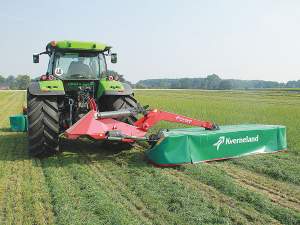Kverneland to debut Alentix fertiliser spreaders at Agritechnica
With Agritechnica just around the corner, it’s no surprise to see manufacturers drip-feed some information of new products worth a closer look.
 New features to the mower make a real difference to cutting performance and the cost of ownership, says the manufacturer.
New features to the mower make a real difference to cutting performance and the cost of ownership, says the manufacturer.
With spring upon us, thoughts turn towards shutting up paddocks for conservation and maybe the purchase of new machinery to get the job done. The latest 28 Series disc mowers from Kverneland offer several features that the manufacturer says make a real difference to cutting performance and the cost of ownership.
At the heart of the machine, KV's own cutter-bar takes the form of two C-shaped steel profiles that are brought together with a single welded seam. This creates a torsional-rigid cutter-bar with massive strenght, no leaks, a high oil capacity, no maintenance and an extended service life. The unique round cutting discs also ensure there are no "pinch" points for stones or matted crop, while quick change blades make it easy to ensure cutting quality.
Available in 3.2m (8-disc), 3.6m (9-disc) and 4.0m (10-disc) set ups, the 2832, 2836 and 2840 models feature a heavy-duty headstock and frame, using a centre pivot layout to support the mowing element. Ground adaption and suspension is taken care of by HD coil spring system that responds quickly to changing conditions and is easy to adjust.
Offering a shaft-drive layout, overload protection is taken care of by a slip clutch and a breakaway device is incorporated into the lower link position, meaning that if an obstacle is encountered, the mower unit can break back, then reset after the obstruction is cleared.
Requiring only one single-acting hydraulic connection, the mower folds vertically up to 125 degrees from horizontal, pulling the cutter-bar inside the line of the tractor’s offside rear fender for transport, while also increasing stability at road transport speeds.
Product manager for distributor Power Farming Group, Shane Cox, says “the 28 Series machines are very heavyduty machines, so are ideally suited to larger scale farms or in contracting operations”.
Likewise, for those wishing to push moisture out of mown crops, the Kverneland Proline 8500 Series tedders take on many of the same attributes.
Available in 5.5 or 7.6 metre working widths, the 8555 and 8576 models are 4 or 6-rotor machines, featuring a heavy-duty box section main beam, to which permanent oil-bath gearboxes are bolted, thereby eliminating and stress loadings passed through the machine. Internally, the rotor gearboxes feature pinion shafts that are supported by twin bearing assemblies, said to eliminate distortion extreme loadings, while ensuring that gear engagement remains constant, so extending the service life of the machine.
Each rotor assembly is equipped with seven flat steel tine arms, which in turn carry Super-C tines, with equal-length arms to promote even spread over the full working width. Each tine, manufactured from 10mm diameter, shot-peened spring steel, is fitted with twin 80mm diameter coil springs, so are suited to heavy crop conditions.
Tine angle can be adjusted to offer aggressive angles depending on crop, while a border spreading function reduces spreading width to keep material under control on headlands or alongside drains.
During folding to a 2.95m transport width, maintenance free rollers ensure correct alignment of the wing sections, while double universal joints help reduce shocks or torsional loading being transmitted through the driveline.
When American retail giant Cosco came to audit Open Country Dairy’s new butter plant at the Waharoa site and give the green light to supply their American stores, they allowed themselves a week for the exercise.
Fonterra chair Peter McBride says the divestment of Mainland Group is their last significant asset sale and signals the end of structural changes.
Thirty years ago, as a young sharemilker, former Waikato farmer Snow Chubb realised he was bucking a trend when he started planting trees to provide shade for his cows, but he knew the animals would appreciate what he was doing.
Virtual fencing and herding systems supplier, Halter is welcoming a decision by the Victorian Government to allow farmers in the state to use the technology.
DairyNZ’s latest Econ Tracker update shows most farms will still finish the season in a positive position, although the gap has narrowed compared with early season expectations.
New Zealand’s national lamb crop for the 2025–26 season is estimated at 19.66 million head, a lift of one percent (or 188,000 more lambs) on last season, according to Beef + Lamb New Zealand’s (B+LNZ) latest Lamb Crop report.
President Donald Trump’s decision to impose tariffs on imports into the US is doing good things for global trade, according…
Seen a giant cheese roll rolling along Southland’s roads?